Social Psychology Report: Interview Analysis of Abrasive Personality
VerifiedAdded on 2023/06/11
|14
|3402
|57
Report
AI Summary
This report provides an analysis of an interview conducted with Dr. Alexander, a neurosurgeon exhibiting abrasive personality traits. The analysis utilizes psychological theories such as Prochaska and Norcross's five-stage client change model, Bem's self-perception theory, and the theory of planned behavior to understand Dr. Alexander's behavior and potential for change. The interview process aimed to facilitate self-realization, create an attitude for change, and assess the rate of competitiveness driving his behavior. Critical reflection on the approaches used during the interview highlights the importance of self-recognition and understanding the underlying motivations behind Dr. Alexander's actions. Recommendations for improving the interview process include incorporating more direct questions and focusing on the importance of politeness and teamwork to foster a more positive and collaborative environment. The report concludes by emphasizing the need for ongoing support and intervention to help Dr. Alexander progress through the stages of change and modify his dysfunctional behavior. Desklib offers similar assignments and past papers for students.
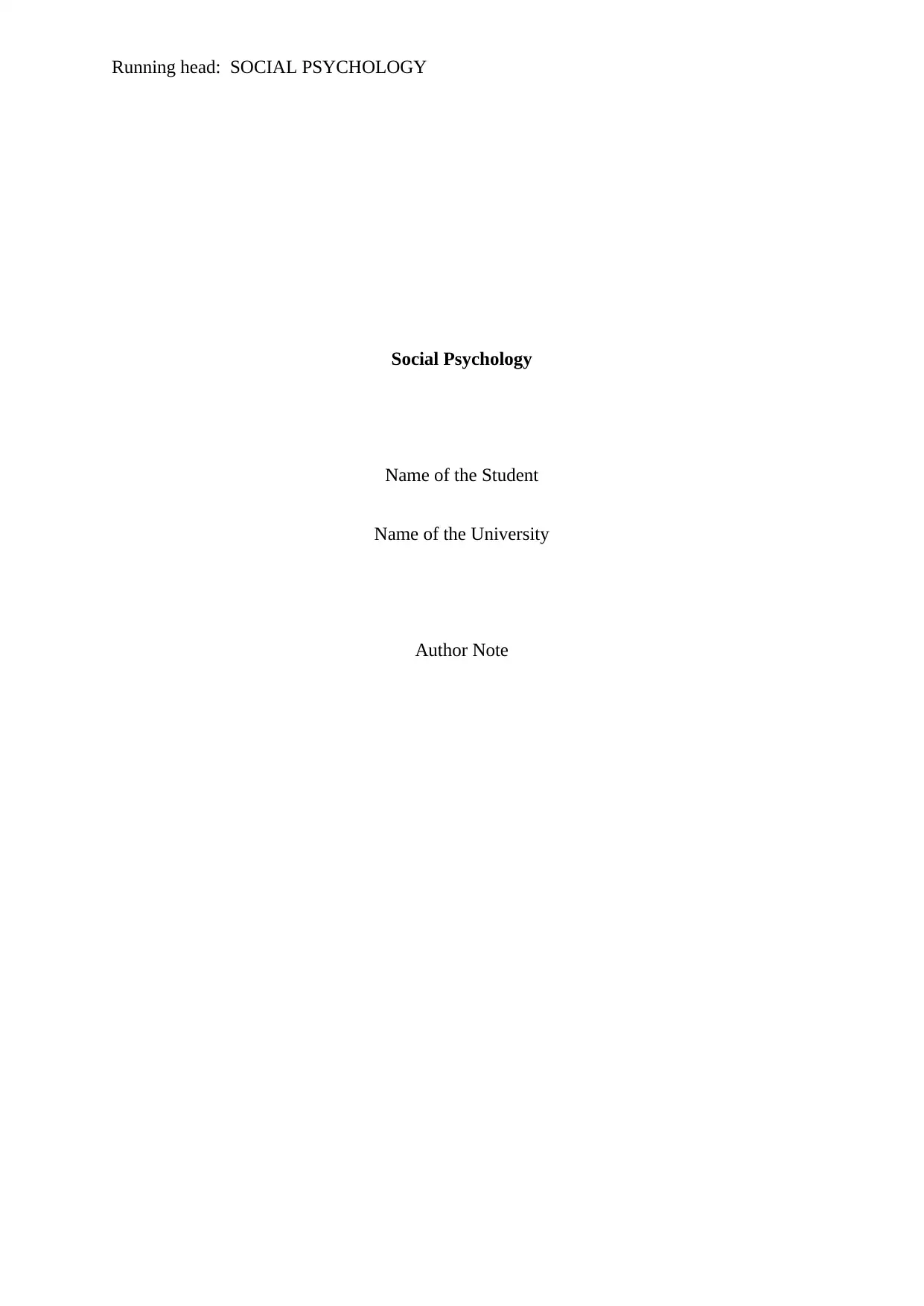
Running head: SOCIAL PSYCHOLOGY
Social Psychology
Name of the Student
Name of the University
Author Note
Social Psychology
Name of the Student
Name of the University
Author Note
Paraphrase This Document
Need a fresh take? Get an instant paraphrase of this document with our AI Paraphraser
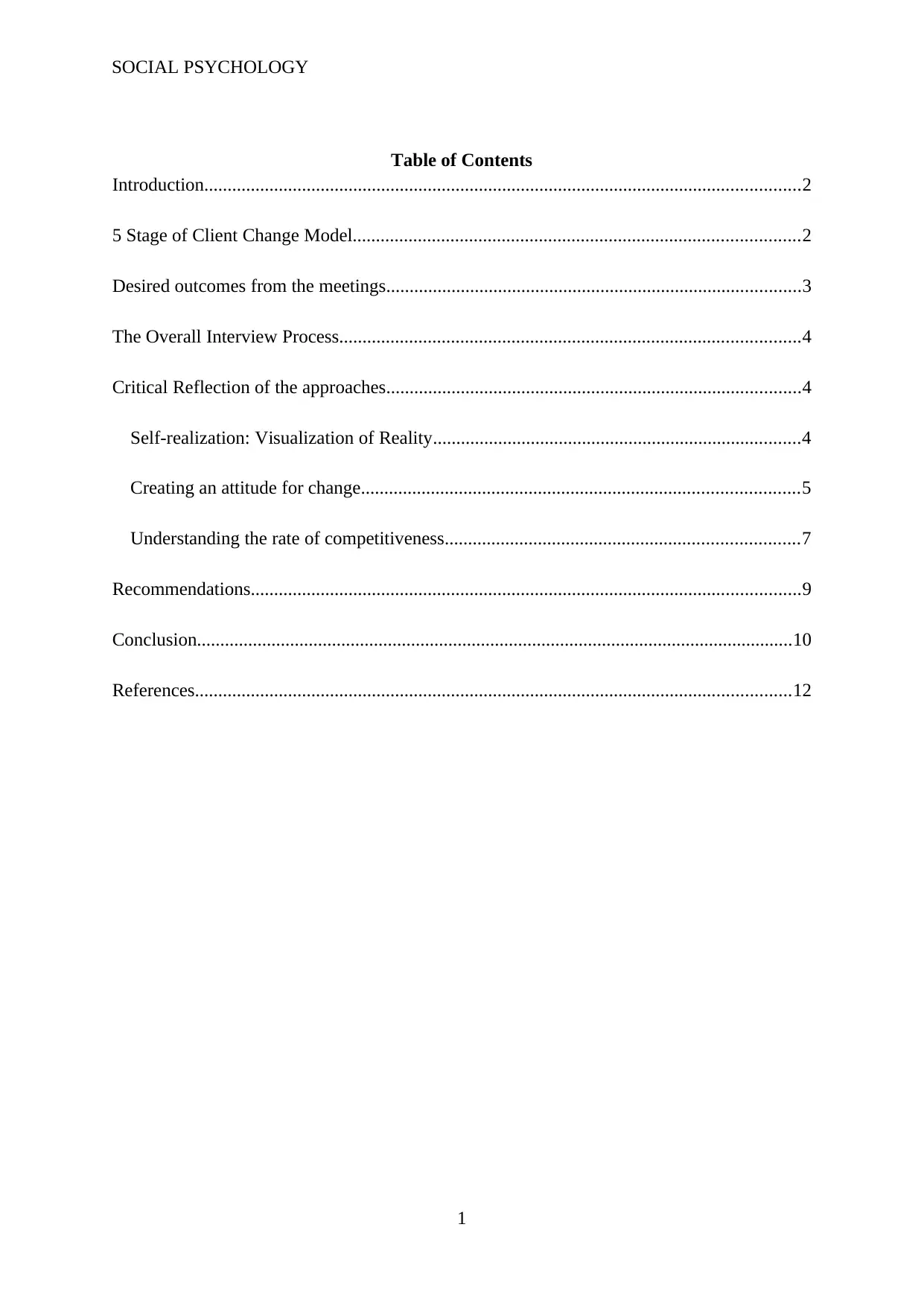
SOCIAL PSYCHOLOGY
Table of Contents
Introduction................................................................................................................................2
5 Stage of Client Change Model................................................................................................2
Desired outcomes from the meetings.........................................................................................3
The Overall Interview Process...................................................................................................4
Critical Reflection of the approaches.........................................................................................4
Self-realization: Visualization of Reality...............................................................................4
Creating an attitude for change..............................................................................................5
Understanding the rate of competitiveness............................................................................7
Recommendations......................................................................................................................9
Conclusion................................................................................................................................10
References................................................................................................................................12
1
Table of Contents
Introduction................................................................................................................................2
5 Stage of Client Change Model................................................................................................2
Desired outcomes from the meetings.........................................................................................3
The Overall Interview Process...................................................................................................4
Critical Reflection of the approaches.........................................................................................4
Self-realization: Visualization of Reality...............................................................................4
Creating an attitude for change..............................................................................................5
Understanding the rate of competitiveness............................................................................7
Recommendations......................................................................................................................9
Conclusion................................................................................................................................10
References................................................................................................................................12
1
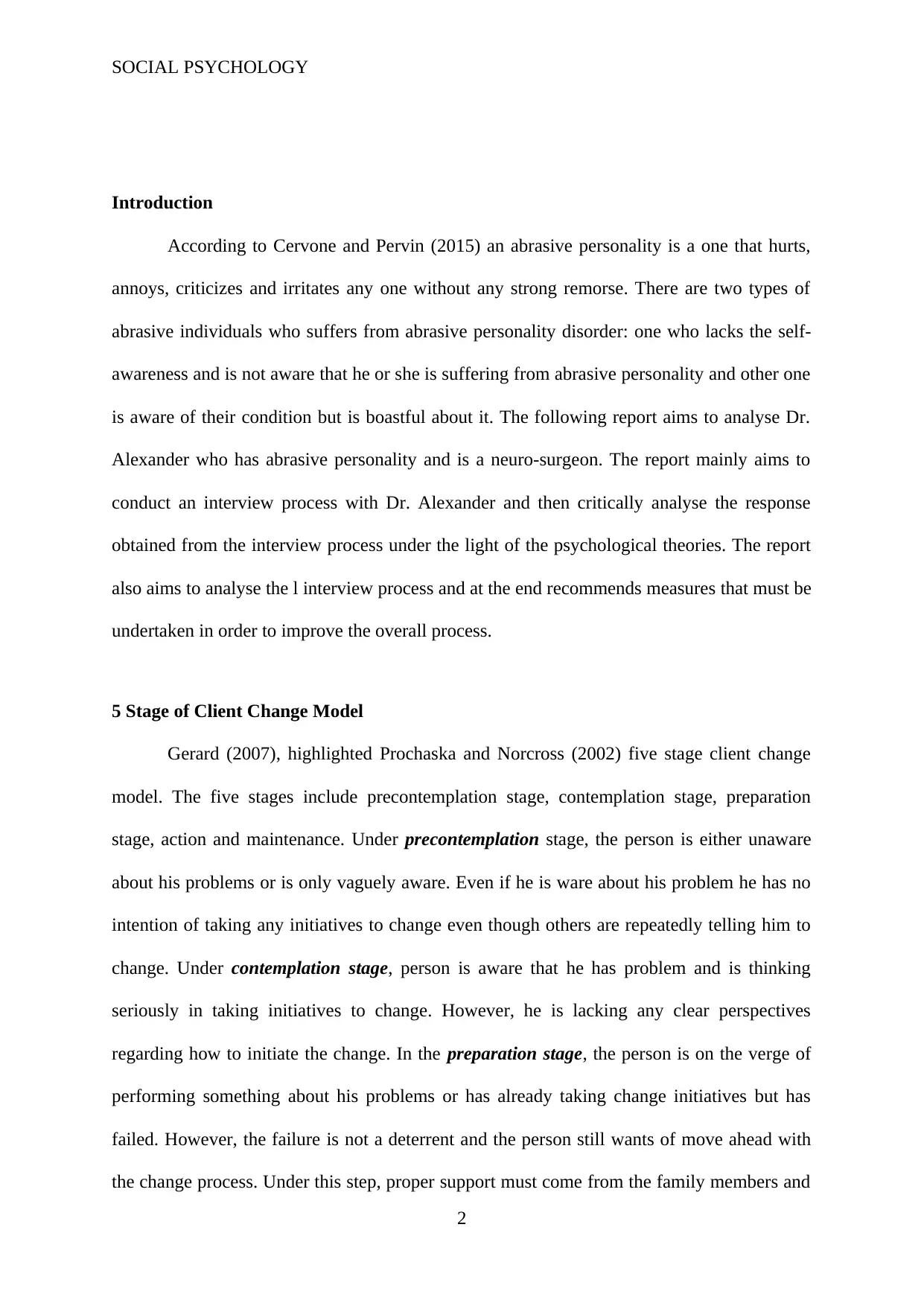
SOCIAL PSYCHOLOGY
Introduction
According to Cervone and Pervin (2015) an abrasive personality is a one that hurts,
annoys, criticizes and irritates any one without any strong remorse. There are two types of
abrasive individuals who suffers from abrasive personality disorder: one who lacks the self-
awareness and is not aware that he or she is suffering from abrasive personality and other one
is aware of their condition but is boastful about it. The following report aims to analyse Dr.
Alexander who has abrasive personality and is a neuro-surgeon. The report mainly aims to
conduct an interview process with Dr. Alexander and then critically analyse the response
obtained from the interview process under the light of the psychological theories. The report
also aims to analyse the l interview process and at the end recommends measures that must be
undertaken in order to improve the overall process.
5 Stage of Client Change Model
Gerard (2007), highlighted Prochaska and Norcross (2002) five stage client change
model. The five stages include precontemplation stage, contemplation stage, preparation
stage, action and maintenance. Under precontemplation stage, the person is either unaware
about his problems or is only vaguely aware. Even if he is ware about his problem he has no
intention of taking any initiatives to change even though others are repeatedly telling him to
change. Under contemplation stage, person is aware that he has problem and is thinking
seriously in taking initiatives to change. However, he is lacking any clear perspectives
regarding how to initiate the change. In the preparation stage, the person is on the verge of
performing something about his problems or has already taking change initiatives but has
failed. However, the failure is not a deterrent and the person still wants of move ahead with
the change process. Under this step, proper support must come from the family members and
2
Introduction
According to Cervone and Pervin (2015) an abrasive personality is a one that hurts,
annoys, criticizes and irritates any one without any strong remorse. There are two types of
abrasive individuals who suffers from abrasive personality disorder: one who lacks the self-
awareness and is not aware that he or she is suffering from abrasive personality and other one
is aware of their condition but is boastful about it. The following report aims to analyse Dr.
Alexander who has abrasive personality and is a neuro-surgeon. The report mainly aims to
conduct an interview process with Dr. Alexander and then critically analyse the response
obtained from the interview process under the light of the psychological theories. The report
also aims to analyse the l interview process and at the end recommends measures that must be
undertaken in order to improve the overall process.
5 Stage of Client Change Model
Gerard (2007), highlighted Prochaska and Norcross (2002) five stage client change
model. The five stages include precontemplation stage, contemplation stage, preparation
stage, action and maintenance. Under precontemplation stage, the person is either unaware
about his problems or is only vaguely aware. Even if he is ware about his problem he has no
intention of taking any initiatives to change even though others are repeatedly telling him to
change. Under contemplation stage, person is aware that he has problem and is thinking
seriously in taking initiatives to change. However, he is lacking any clear perspectives
regarding how to initiate the change. In the preparation stage, the person is on the verge of
performing something about his problems or has already taking change initiatives but has
failed. However, the failure is not a deterrent and the person still wants of move ahead with
the change process. Under this step, proper support must come from the family members and
2
⊘ This is a preview!⊘
Do you want full access?
Subscribe today to unlock all pages.

Trusted by 1+ million students worldwide
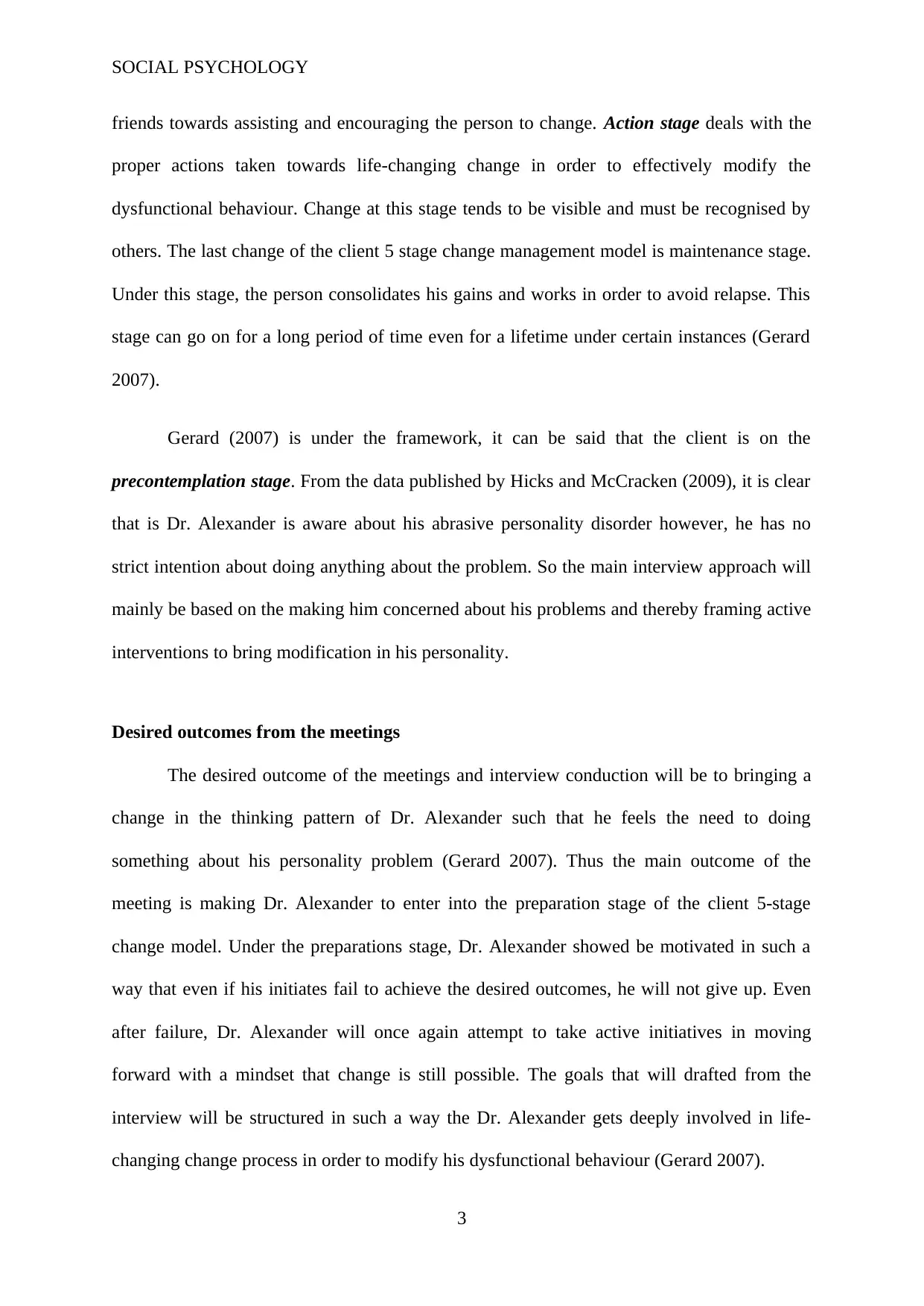
SOCIAL PSYCHOLOGY
friends towards assisting and encouraging the person to change. Action stage deals with the
proper actions taken towards life-changing change in order to effectively modify the
dysfunctional behaviour. Change at this stage tends to be visible and must be recognised by
others. The last change of the client 5 stage change management model is maintenance stage.
Under this stage, the person consolidates his gains and works in order to avoid relapse. This
stage can go on for a long period of time even for a lifetime under certain instances (Gerard
2007).
Gerard (2007) is under the framework, it can be said that the client is on the
precontemplation stage. From the data published by Hicks and McCracken (2009), it is clear
that is Dr. Alexander is aware about his abrasive personality disorder however, he has no
strict intention about doing anything about the problem. So the main interview approach will
mainly be based on the making him concerned about his problems and thereby framing active
interventions to bring modification in his personality.
Desired outcomes from the meetings
The desired outcome of the meetings and interview conduction will be to bringing a
change in the thinking pattern of Dr. Alexander such that he feels the need to doing
something about his personality problem (Gerard 2007). Thus the main outcome of the
meeting is making Dr. Alexander to enter into the preparation stage of the client 5-stage
change model. Under the preparations stage, Dr. Alexander showed be motivated in such a
way that even if his initiates fail to achieve the desired outcomes, he will not give up. Even
after failure, Dr. Alexander will once again attempt to take active initiatives in moving
forward with a mindset that change is still possible. The goals that will drafted from the
interview will be structured in such a way the Dr. Alexander gets deeply involved in life-
changing change process in order to modify his dysfunctional behaviour (Gerard 2007).
3
friends towards assisting and encouraging the person to change. Action stage deals with the
proper actions taken towards life-changing change in order to effectively modify the
dysfunctional behaviour. Change at this stage tends to be visible and must be recognised by
others. The last change of the client 5 stage change management model is maintenance stage.
Under this stage, the person consolidates his gains and works in order to avoid relapse. This
stage can go on for a long period of time even for a lifetime under certain instances (Gerard
2007).
Gerard (2007) is under the framework, it can be said that the client is on the
precontemplation stage. From the data published by Hicks and McCracken (2009), it is clear
that is Dr. Alexander is aware about his abrasive personality disorder however, he has no
strict intention about doing anything about the problem. So the main interview approach will
mainly be based on the making him concerned about his problems and thereby framing active
interventions to bring modification in his personality.
Desired outcomes from the meetings
The desired outcome of the meetings and interview conduction will be to bringing a
change in the thinking pattern of Dr. Alexander such that he feels the need to doing
something about his personality problem (Gerard 2007). Thus the main outcome of the
meeting is making Dr. Alexander to enter into the preparation stage of the client 5-stage
change model. Under the preparations stage, Dr. Alexander showed be motivated in such a
way that even if his initiates fail to achieve the desired outcomes, he will not give up. Even
after failure, Dr. Alexander will once again attempt to take active initiatives in moving
forward with a mindset that change is still possible. The goals that will drafted from the
interview will be structured in such a way the Dr. Alexander gets deeply involved in life-
changing change process in order to modify his dysfunctional behaviour (Gerard 2007).
3
Paraphrase This Document
Need a fresh take? Get an instant paraphrase of this document with our AI Paraphraser
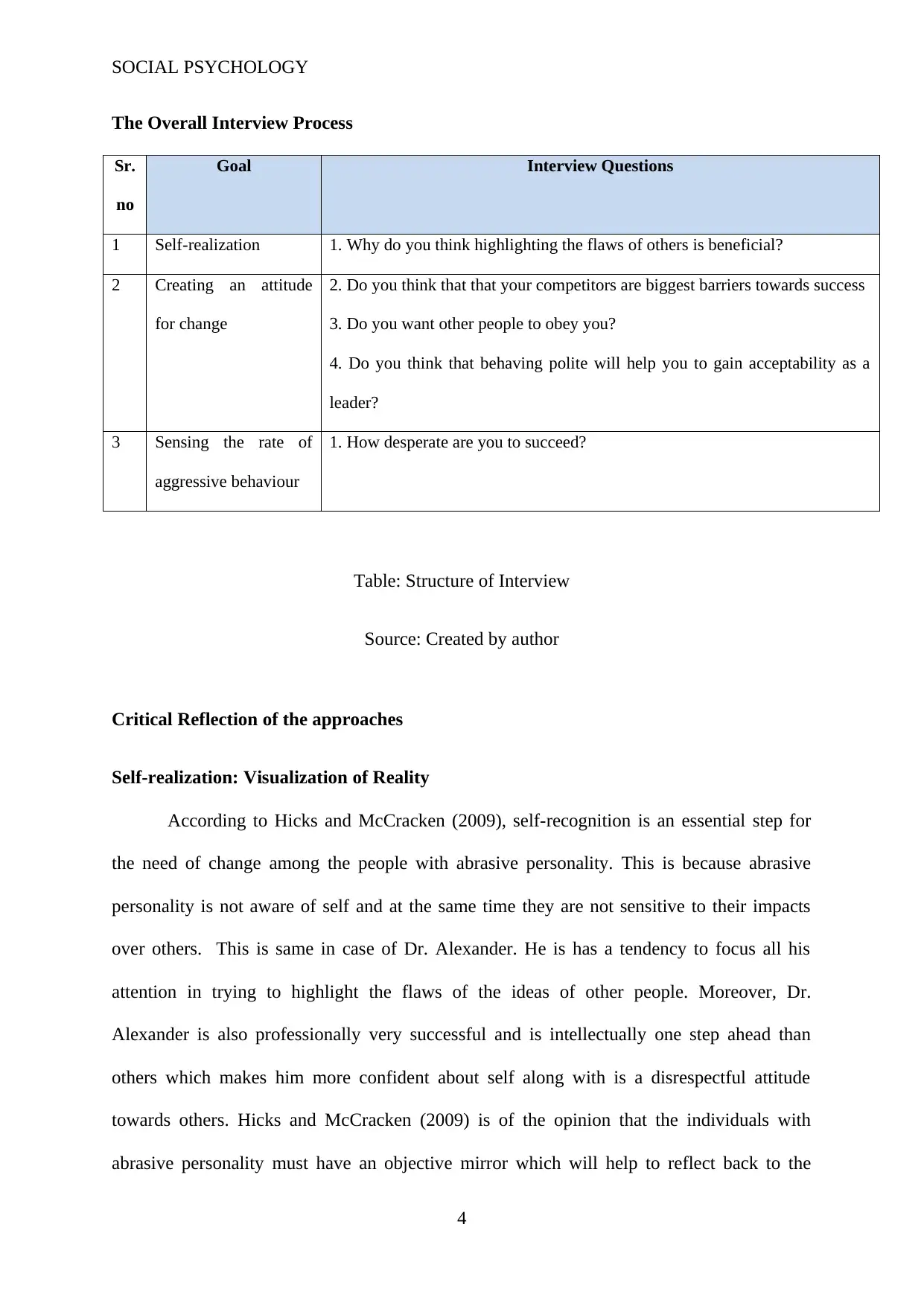
SOCIAL PSYCHOLOGY
The Overall Interview Process
Sr.
no
Goal Interview Questions
1 Self-realization 1. Why do you think highlighting the flaws of others is beneficial?
2 Creating an attitude
for change
2. Do you think that that your competitors are biggest barriers towards success
3. Do you want other people to obey you?
4. Do you think that behaving polite will help you to gain acceptability as a
leader?
3 Sensing the rate of
aggressive behaviour
1. How desperate are you to succeed?
Table: Structure of Interview
Source: Created by author
Critical Reflection of the approaches
Self-realization: Visualization of Reality
According to Hicks and McCracken (2009), self-recognition is an essential step for
the need of change among the people with abrasive personality. This is because abrasive
personality is not aware of self and at the same time they are not sensitive to their impacts
over others. This is same in case of Dr. Alexander. He is has a tendency to focus all his
attention in trying to highlight the flaws of the ideas of other people. Moreover, Dr.
Alexander is also professionally very successful and is intellectually one step ahead than
others which makes him more confident about self along with is a disrespectful attitude
towards others. Hicks and McCracken (2009) is of the opinion that the individuals with
abrasive personality must have an objective mirror which will help to reflect back to the
4
The Overall Interview Process
Sr.
no
Goal Interview Questions
1 Self-realization 1. Why do you think highlighting the flaws of others is beneficial?
2 Creating an attitude
for change
2. Do you think that that your competitors are biggest barriers towards success
3. Do you want other people to obey you?
4. Do you think that behaving polite will help you to gain acceptability as a
leader?
3 Sensing the rate of
aggressive behaviour
1. How desperate are you to succeed?
Table: Structure of Interview
Source: Created by author
Critical Reflection of the approaches
Self-realization: Visualization of Reality
According to Hicks and McCracken (2009), self-recognition is an essential step for
the need of change among the people with abrasive personality. This is because abrasive
personality is not aware of self and at the same time they are not sensitive to their impacts
over others. This is same in case of Dr. Alexander. He is has a tendency to focus all his
attention in trying to highlight the flaws of the ideas of other people. Moreover, Dr.
Alexander is also professionally very successful and is intellectually one step ahead than
others which makes him more confident about self along with is a disrespectful attitude
towards others. Hicks and McCracken (2009) is of the opinion that the individuals with
abrasive personality must have an objective mirror which will help to reflect back to the
4
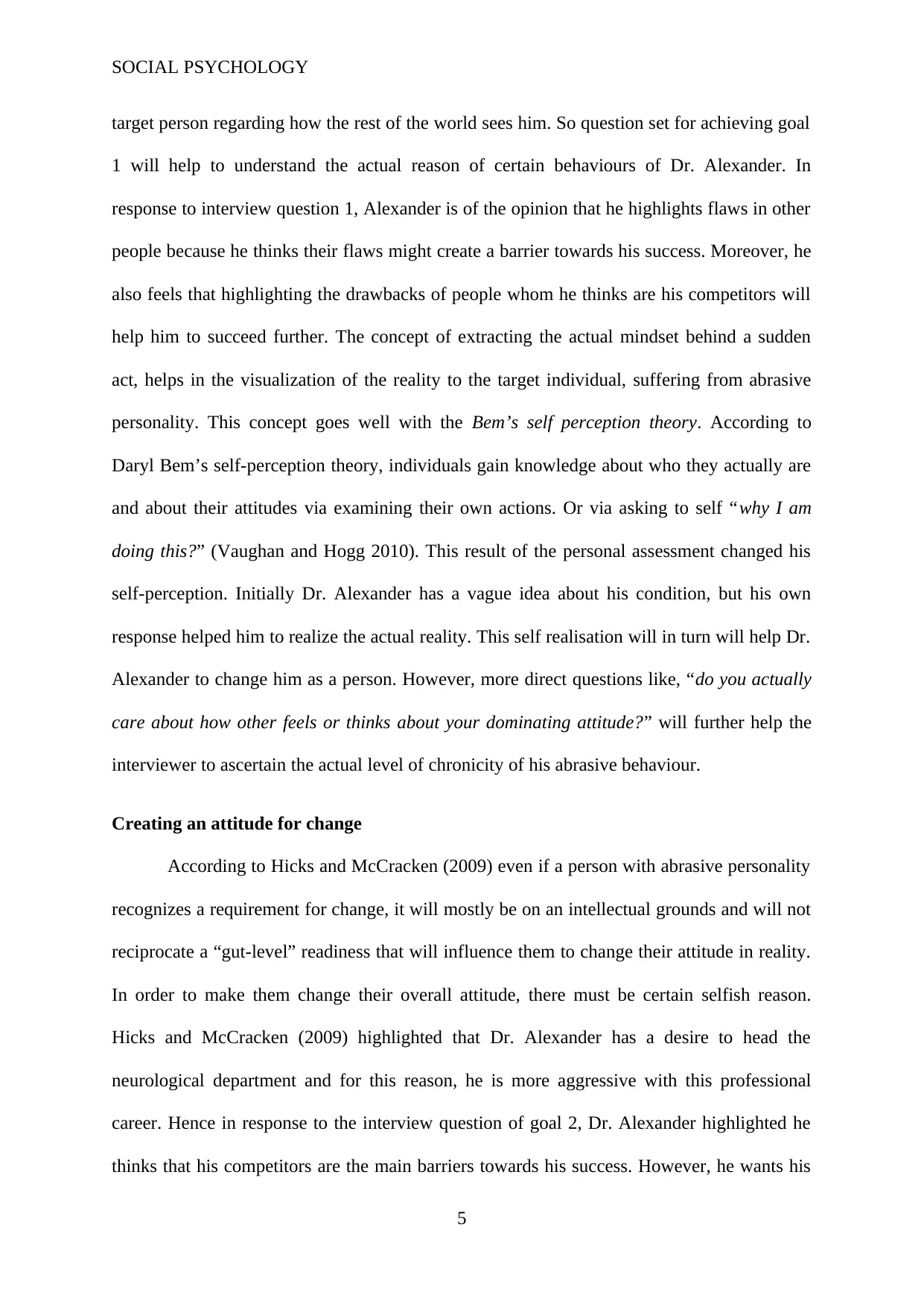
SOCIAL PSYCHOLOGY
target person regarding how the rest of the world sees him. So question set for achieving goal
1 will help to understand the actual reason of certain behaviours of Dr. Alexander. In
response to interview question 1, Alexander is of the opinion that he highlights flaws in other
people because he thinks their flaws might create a barrier towards his success. Moreover, he
also feels that highlighting the drawbacks of people whom he thinks are his competitors will
help him to succeed further. The concept of extracting the actual mindset behind a sudden
act, helps in the visualization of the reality to the target individual, suffering from abrasive
personality. This concept goes well with the Bem’s self perception theory. According to
Daryl Bem’s self-perception theory, individuals gain knowledge about who they actually are
and about their attitudes via examining their own actions. Or via asking to self “why I am
doing this?” (Vaughan and Hogg 2010). This result of the personal assessment changed his
self-perception. Initially Dr. Alexander has a vague idea about his condition, but his own
response helped him to realize the actual reality. This self realisation will in turn will help Dr.
Alexander to change him as a person. However, more direct questions like, “do you actually
care about how other feels or thinks about your dominating attitude?” will further help the
interviewer to ascertain the actual level of chronicity of his abrasive behaviour.
Creating an attitude for change
According to Hicks and McCracken (2009) even if a person with abrasive personality
recognizes a requirement for change, it will mostly be on an intellectual grounds and will not
reciprocate a “gut-level” readiness that will influence them to change their attitude in reality.
In order to make them change their overall attitude, there must be certain selfish reason.
Hicks and McCracken (2009) highlighted that Dr. Alexander has a desire to head the
neurological department and for this reason, he is more aggressive with this professional
career. Hence in response to the interview question of goal 2, Dr. Alexander highlighted he
thinks that his competitors are the main barriers towards his success. However, he wants his
5
target person regarding how the rest of the world sees him. So question set for achieving goal
1 will help to understand the actual reason of certain behaviours of Dr. Alexander. In
response to interview question 1, Alexander is of the opinion that he highlights flaws in other
people because he thinks their flaws might create a barrier towards his success. Moreover, he
also feels that highlighting the drawbacks of people whom he thinks are his competitors will
help him to succeed further. The concept of extracting the actual mindset behind a sudden
act, helps in the visualization of the reality to the target individual, suffering from abrasive
personality. This concept goes well with the Bem’s self perception theory. According to
Daryl Bem’s self-perception theory, individuals gain knowledge about who they actually are
and about their attitudes via examining their own actions. Or via asking to self “why I am
doing this?” (Vaughan and Hogg 2010). This result of the personal assessment changed his
self-perception. Initially Dr. Alexander has a vague idea about his condition, but his own
response helped him to realize the actual reality. This self realisation will in turn will help Dr.
Alexander to change him as a person. However, more direct questions like, “do you actually
care about how other feels or thinks about your dominating attitude?” will further help the
interviewer to ascertain the actual level of chronicity of his abrasive behaviour.
Creating an attitude for change
According to Hicks and McCracken (2009) even if a person with abrasive personality
recognizes a requirement for change, it will mostly be on an intellectual grounds and will not
reciprocate a “gut-level” readiness that will influence them to change their attitude in reality.
In order to make them change their overall attitude, there must be certain selfish reason.
Hicks and McCracken (2009) highlighted that Dr. Alexander has a desire to head the
neurological department and for this reason, he is more aggressive with this professional
career. Hence in response to the interview question of goal 2, Dr. Alexander highlighted he
thinks that his competitors are the main barriers towards his success. However, he wants his
5
⊘ This is a preview!⊘
Do you want full access?
Subscribe today to unlock all pages.

Trusted by 1+ million students worldwide
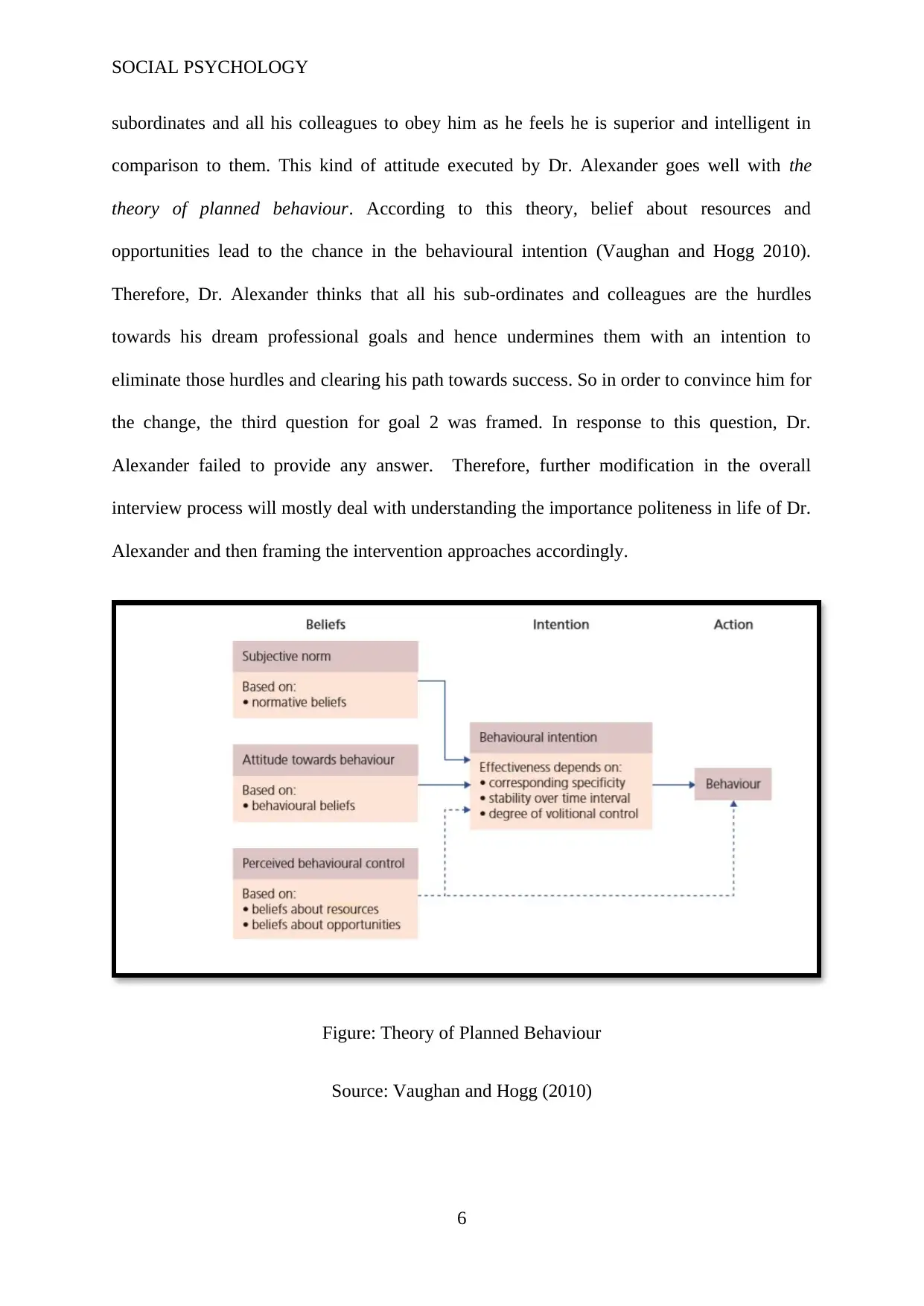
SOCIAL PSYCHOLOGY
subordinates and all his colleagues to obey him as he feels he is superior and intelligent in
comparison to them. This kind of attitude executed by Dr. Alexander goes well with the
theory of planned behaviour. According to this theory, belief about resources and
opportunities lead to the chance in the behavioural intention (Vaughan and Hogg 2010).
Therefore, Dr. Alexander thinks that all his sub-ordinates and colleagues are the hurdles
towards his dream professional goals and hence undermines them with an intention to
eliminate those hurdles and clearing his path towards success. So in order to convince him for
the change, the third question for goal 2 was framed. In response to this question, Dr.
Alexander failed to provide any answer. Therefore, further modification in the overall
interview process will mostly deal with understanding the importance politeness in life of Dr.
Alexander and then framing the intervention approaches accordingly.
Figure: Theory of Planned Behaviour
Source: Vaughan and Hogg (2010)
6
subordinates and all his colleagues to obey him as he feels he is superior and intelligent in
comparison to them. This kind of attitude executed by Dr. Alexander goes well with the
theory of planned behaviour. According to this theory, belief about resources and
opportunities lead to the chance in the behavioural intention (Vaughan and Hogg 2010).
Therefore, Dr. Alexander thinks that all his sub-ordinates and colleagues are the hurdles
towards his dream professional goals and hence undermines them with an intention to
eliminate those hurdles and clearing his path towards success. So in order to convince him for
the change, the third question for goal 2 was framed. In response to this question, Dr.
Alexander failed to provide any answer. Therefore, further modification in the overall
interview process will mostly deal with understanding the importance politeness in life of Dr.
Alexander and then framing the intervention approaches accordingly.
Figure: Theory of Planned Behaviour
Source: Vaughan and Hogg (2010)
6
Paraphrase This Document
Need a fresh take? Get an instant paraphrase of this document with our AI Paraphraser
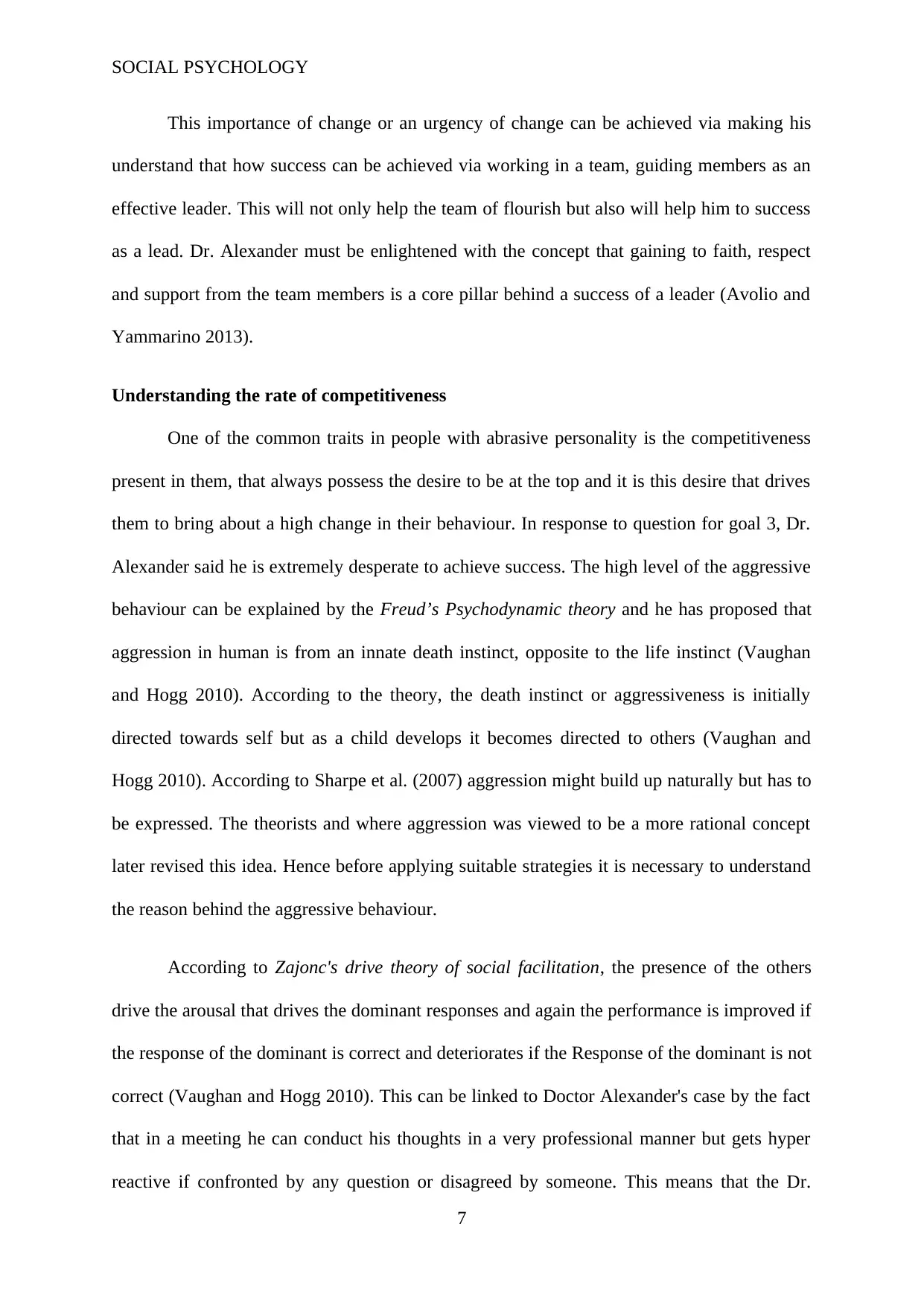
SOCIAL PSYCHOLOGY
This importance of change or an urgency of change can be achieved via making his
understand that how success can be achieved via working in a team, guiding members as an
effective leader. This will not only help the team of flourish but also will help him to success
as a lead. Dr. Alexander must be enlightened with the concept that gaining to faith, respect
and support from the team members is a core pillar behind a success of a leader (Avolio and
Yammarino 2013).
Understanding the rate of competitiveness
One of the common traits in people with abrasive personality is the competitiveness
present in them, that always possess the desire to be at the top and it is this desire that drives
them to bring about a high change in their behaviour. In response to question for goal 3, Dr.
Alexander said he is extremely desperate to achieve success. The high level of the aggressive
behaviour can be explained by the Freud’s Psychodynamic theory and he has proposed that
aggression in human is from an innate death instinct, opposite to the life instinct (Vaughan
and Hogg 2010). According to the theory, the death instinct or aggressiveness is initially
directed towards self but as a child develops it becomes directed to others (Vaughan and
Hogg 2010). According to Sharpe et al. (2007) aggression might build up naturally but has to
be expressed. The theorists and where aggression was viewed to be a more rational concept
later revised this idea. Hence before applying suitable strategies it is necessary to understand
the reason behind the aggressive behaviour.
According to Zajonc's drive theory of social facilitation, the presence of the others
drive the arousal that drives the dominant responses and again the performance is improved if
the response of the dominant is correct and deteriorates if the Response of the dominant is not
correct (Vaughan and Hogg 2010). This can be linked to Doctor Alexander's case by the fact
that in a meeting he can conduct his thoughts in a very professional manner but gets hyper
reactive if confronted by any question or disagreed by someone. This means that the Dr.
7
This importance of change or an urgency of change can be achieved via making his
understand that how success can be achieved via working in a team, guiding members as an
effective leader. This will not only help the team of flourish but also will help him to success
as a lead. Dr. Alexander must be enlightened with the concept that gaining to faith, respect
and support from the team members is a core pillar behind a success of a leader (Avolio and
Yammarino 2013).
Understanding the rate of competitiveness
One of the common traits in people with abrasive personality is the competitiveness
present in them, that always possess the desire to be at the top and it is this desire that drives
them to bring about a high change in their behaviour. In response to question for goal 3, Dr.
Alexander said he is extremely desperate to achieve success. The high level of the aggressive
behaviour can be explained by the Freud’s Psychodynamic theory and he has proposed that
aggression in human is from an innate death instinct, opposite to the life instinct (Vaughan
and Hogg 2010). According to the theory, the death instinct or aggressiveness is initially
directed towards self but as a child develops it becomes directed to others (Vaughan and
Hogg 2010). According to Sharpe et al. (2007) aggression might build up naturally but has to
be expressed. The theorists and where aggression was viewed to be a more rational concept
later revised this idea. Hence before applying suitable strategies it is necessary to understand
the reason behind the aggressive behaviour.
According to Zajonc's drive theory of social facilitation, the presence of the others
drive the arousal that drives the dominant responses and again the performance is improved if
the response of the dominant is correct and deteriorates if the Response of the dominant is not
correct (Vaughan and Hogg 2010). This can be linked to Doctor Alexander's case by the fact
that in a meeting he can conduct his thoughts in a very professional manner but gets hyper
reactive if confronted by any question or disagreed by someone. This means that the Dr.
7
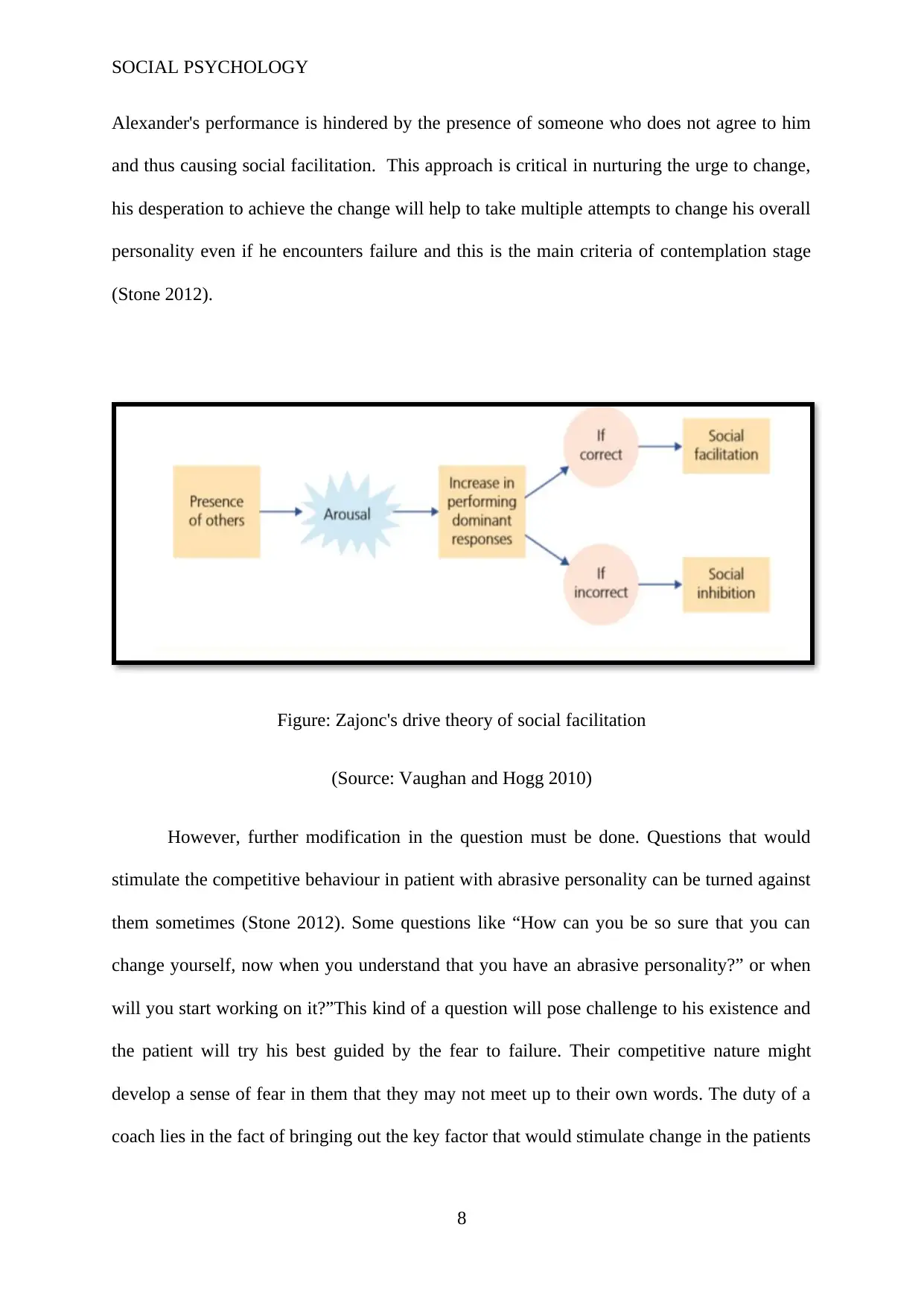
SOCIAL PSYCHOLOGY
Alexander's performance is hindered by the presence of someone who does not agree to him
and thus causing social facilitation. This approach is critical in nurturing the urge to change,
his desperation to achieve the change will help to take multiple attempts to change his overall
personality even if he encounters failure and this is the main criteria of contemplation stage
(Stone 2012).
Figure: Zajonc's drive theory of social facilitation
(Source: Vaughan and Hogg 2010)
However, further modification in the question must be done. Questions that would
stimulate the competitive behaviour in patient with abrasive personality can be turned against
them sometimes (Stone 2012). Some questions like “How can you be so sure that you can
change yourself, now when you understand that you have an abrasive personality?” or when
will you start working on it?”This kind of a question will pose challenge to his existence and
the patient will try his best guided by the fear to failure. Their competitive nature might
develop a sense of fear in them that they may not meet up to their own words. The duty of a
coach lies in the fact of bringing out the key factor that would stimulate change in the patients
8
Alexander's performance is hindered by the presence of someone who does not agree to him
and thus causing social facilitation. This approach is critical in nurturing the urge to change,
his desperation to achieve the change will help to take multiple attempts to change his overall
personality even if he encounters failure and this is the main criteria of contemplation stage
(Stone 2012).
Figure: Zajonc's drive theory of social facilitation
(Source: Vaughan and Hogg 2010)
However, further modification in the question must be done. Questions that would
stimulate the competitive behaviour in patient with abrasive personality can be turned against
them sometimes (Stone 2012). Some questions like “How can you be so sure that you can
change yourself, now when you understand that you have an abrasive personality?” or when
will you start working on it?”This kind of a question will pose challenge to his existence and
the patient will try his best guided by the fear to failure. Their competitive nature might
develop a sense of fear in them that they may not meet up to their own words. The duty of a
coach lies in the fact of bringing out the key factor that would stimulate change in the patients
8
⊘ This is a preview!⊘
Do you want full access?
Subscribe today to unlock all pages.

Trusted by 1+ million students worldwide
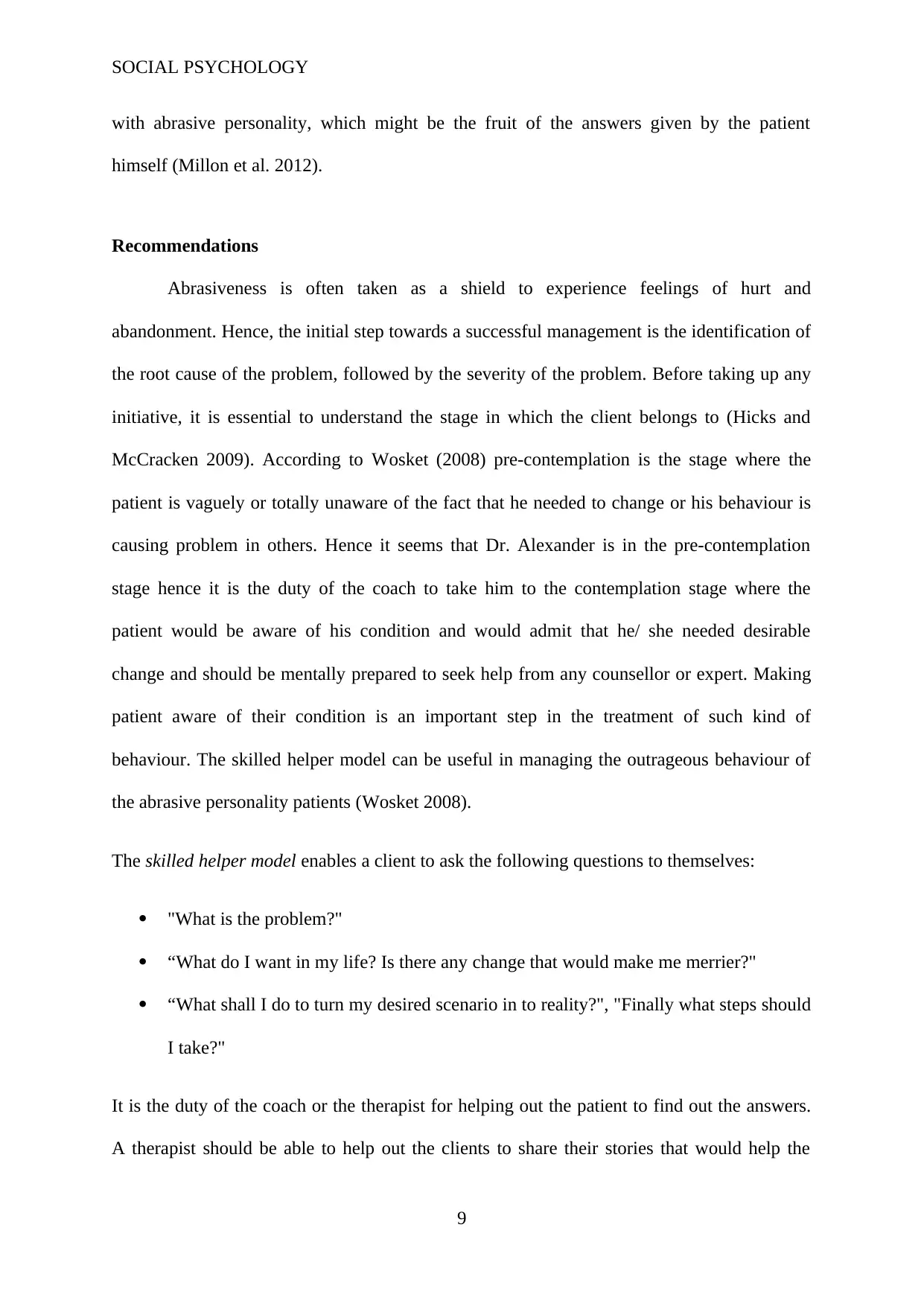
SOCIAL PSYCHOLOGY
with abrasive personality, which might be the fruit of the answers given by the patient
himself (Millon et al. 2012).
Recommendations
Abrasiveness is often taken as a shield to experience feelings of hurt and
abandonment. Hence, the initial step towards a successful management is the identification of
the root cause of the problem, followed by the severity of the problem. Before taking up any
initiative, it is essential to understand the stage in which the client belongs to (Hicks and
McCracken 2009). According to Wosket (2008) pre-contemplation is the stage where the
patient is vaguely or totally unaware of the fact that he needed to change or his behaviour is
causing problem in others. Hence it seems that Dr. Alexander is in the pre-contemplation
stage hence it is the duty of the coach to take him to the contemplation stage where the
patient would be aware of his condition and would admit that he/ she needed desirable
change and should be mentally prepared to seek help from any counsellor or expert. Making
patient aware of their condition is an important step in the treatment of such kind of
behaviour. The skilled helper model can be useful in managing the outrageous behaviour of
the abrasive personality patients (Wosket 2008).
The skilled helper model enables a client to ask the following questions to themselves:
"What is the problem?"
“What do I want in my life? Is there any change that would make me merrier?"
“What shall I do to turn my desired scenario in to reality?", "Finally what steps should
I take?"
It is the duty of the coach or the therapist for helping out the patient to find out the answers.
A therapist should be able to help out the clients to share their stories that would help the
9
with abrasive personality, which might be the fruit of the answers given by the patient
himself (Millon et al. 2012).
Recommendations
Abrasiveness is often taken as a shield to experience feelings of hurt and
abandonment. Hence, the initial step towards a successful management is the identification of
the root cause of the problem, followed by the severity of the problem. Before taking up any
initiative, it is essential to understand the stage in which the client belongs to (Hicks and
McCracken 2009). According to Wosket (2008) pre-contemplation is the stage where the
patient is vaguely or totally unaware of the fact that he needed to change or his behaviour is
causing problem in others. Hence it seems that Dr. Alexander is in the pre-contemplation
stage hence it is the duty of the coach to take him to the contemplation stage where the
patient would be aware of his condition and would admit that he/ she needed desirable
change and should be mentally prepared to seek help from any counsellor or expert. Making
patient aware of their condition is an important step in the treatment of such kind of
behaviour. The skilled helper model can be useful in managing the outrageous behaviour of
the abrasive personality patients (Wosket 2008).
The skilled helper model enables a client to ask the following questions to themselves:
"What is the problem?"
“What do I want in my life? Is there any change that would make me merrier?"
“What shall I do to turn my desired scenario in to reality?", "Finally what steps should
I take?"
It is the duty of the coach or the therapist for helping out the patient to find out the answers.
A therapist should be able to help out the clients to share their stories that would help the
9
Paraphrase This Document
Need a fresh take? Get an instant paraphrase of this document with our AI Paraphraser
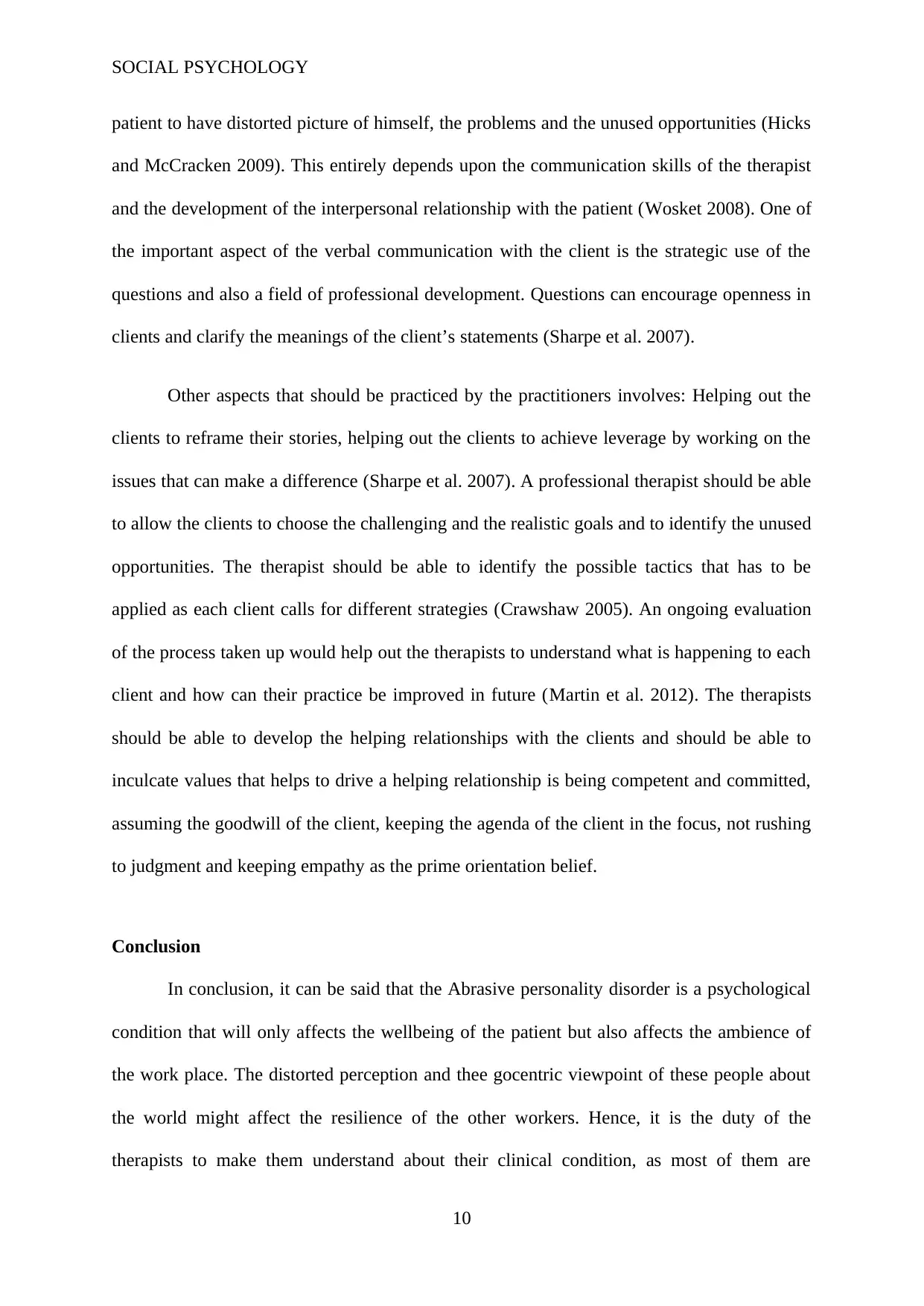
SOCIAL PSYCHOLOGY
patient to have distorted picture of himself, the problems and the unused opportunities (Hicks
and McCracken 2009). This entirely depends upon the communication skills of the therapist
and the development of the interpersonal relationship with the patient (Wosket 2008). One of
the important aspect of the verbal communication with the client is the strategic use of the
questions and also a field of professional development. Questions can encourage openness in
clients and clarify the meanings of the client’s statements (Sharpe et al. 2007).
Other aspects that should be practiced by the practitioners involves: Helping out the
clients to reframe their stories, helping out the clients to achieve leverage by working on the
issues that can make a difference (Sharpe et al. 2007). A professional therapist should be able
to allow the clients to choose the challenging and the realistic goals and to identify the unused
opportunities. The therapist should be able to identify the possible tactics that has to be
applied as each client calls for different strategies (Crawshaw 2005). An ongoing evaluation
of the process taken up would help out the therapists to understand what is happening to each
client and how can their practice be improved in future (Martin et al. 2012). The therapists
should be able to develop the helping relationships with the clients and should be able to
inculcate values that helps to drive a helping relationship is being competent and committed,
assuming the goodwill of the client, keeping the agenda of the client in the focus, not rushing
to judgment and keeping empathy as the prime orientation belief.
Conclusion
In conclusion, it can be said that the Abrasive personality disorder is a psychological
condition that will only affects the wellbeing of the patient but also affects the ambience of
the work place. The distorted perception and thee gocentric viewpoint of these people about
the world might affect the resilience of the other workers. Hence, it is the duty of the
therapists to make them understand about their clinical condition, as most of them are
10
patient to have distorted picture of himself, the problems and the unused opportunities (Hicks
and McCracken 2009). This entirely depends upon the communication skills of the therapist
and the development of the interpersonal relationship with the patient (Wosket 2008). One of
the important aspect of the verbal communication with the client is the strategic use of the
questions and also a field of professional development. Questions can encourage openness in
clients and clarify the meanings of the client’s statements (Sharpe et al. 2007).
Other aspects that should be practiced by the practitioners involves: Helping out the
clients to reframe their stories, helping out the clients to achieve leverage by working on the
issues that can make a difference (Sharpe et al. 2007). A professional therapist should be able
to allow the clients to choose the challenging and the realistic goals and to identify the unused
opportunities. The therapist should be able to identify the possible tactics that has to be
applied as each client calls for different strategies (Crawshaw 2005). An ongoing evaluation
of the process taken up would help out the therapists to understand what is happening to each
client and how can their practice be improved in future (Martin et al. 2012). The therapists
should be able to develop the helping relationships with the clients and should be able to
inculcate values that helps to drive a helping relationship is being competent and committed,
assuming the goodwill of the client, keeping the agenda of the client in the focus, not rushing
to judgment and keeping empathy as the prime orientation belief.
Conclusion
In conclusion, it can be said that the Abrasive personality disorder is a psychological
condition that will only affects the wellbeing of the patient but also affects the ambience of
the work place. The distorted perception and thee gocentric viewpoint of these people about
the world might affect the resilience of the other workers. Hence, it is the duty of the
therapists to make them understand about their clinical condition, as most of them are
10
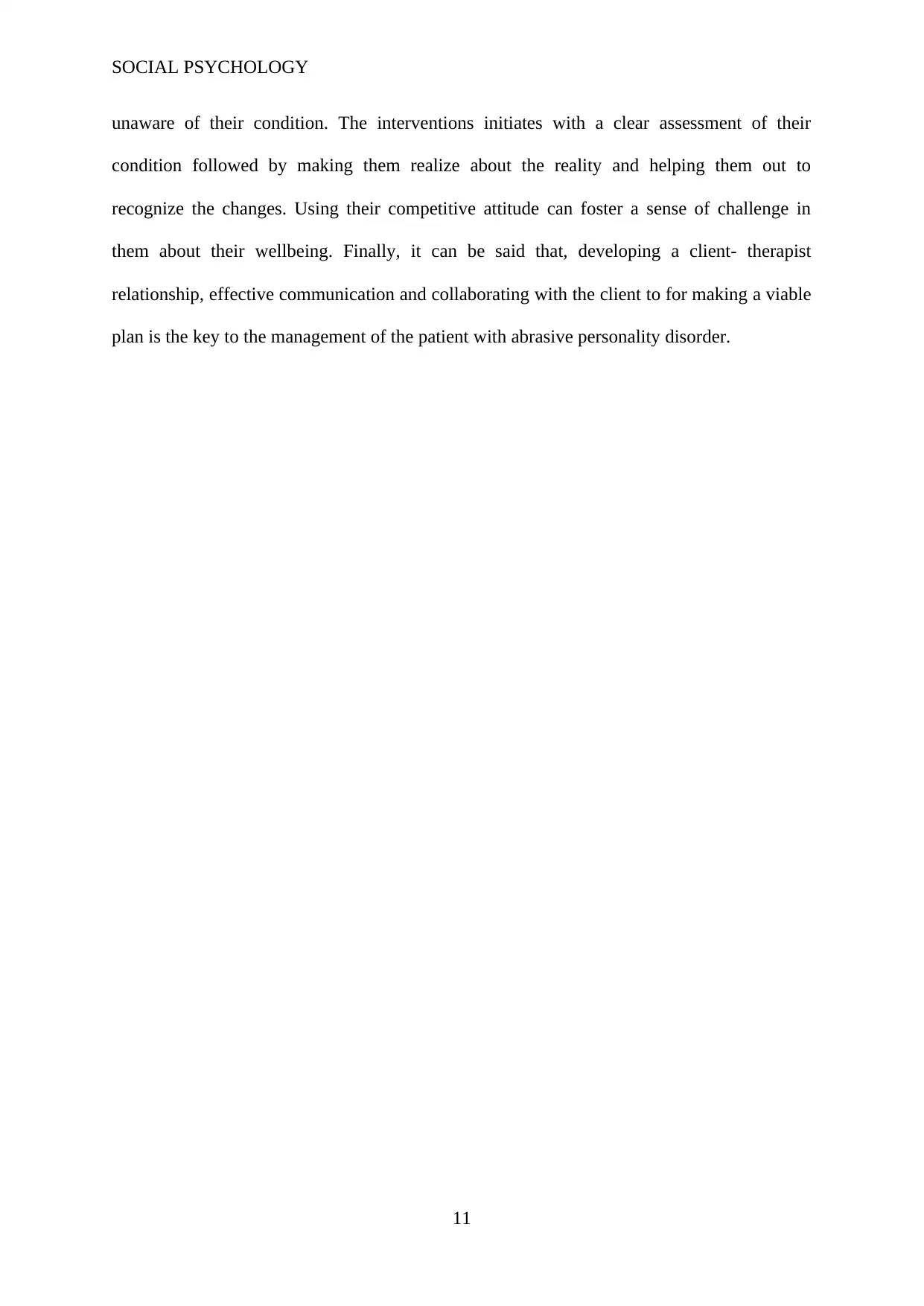
SOCIAL PSYCHOLOGY
unaware of their condition. The interventions initiates with a clear assessment of their
condition followed by making them realize about the reality and helping them out to
recognize the changes. Using their competitive attitude can foster a sense of challenge in
them about their wellbeing. Finally, it can be said that, developing a client- therapist
relationship, effective communication and collaborating with the client to for making a viable
plan is the key to the management of the patient with abrasive personality disorder.
11
unaware of their condition. The interventions initiates with a clear assessment of their
condition followed by making them realize about the reality and helping them out to
recognize the changes. Using their competitive attitude can foster a sense of challenge in
them about their wellbeing. Finally, it can be said that, developing a client- therapist
relationship, effective communication and collaborating with the client to for making a viable
plan is the key to the management of the patient with abrasive personality disorder.
11
⊘ This is a preview!⊘
Do you want full access?
Subscribe today to unlock all pages.

Trusted by 1+ million students worldwide
1 out of 14
Related Documents
Your All-in-One AI-Powered Toolkit for Academic Success.
+13062052269
info@desklib.com
Available 24*7 on WhatsApp / Email
![[object Object]](/_next/static/media/star-bottom.7253800d.svg)
Unlock your academic potential
Copyright © 2020–2025 A2Z Services. All Rights Reserved. Developed and managed by ZUCOL.





